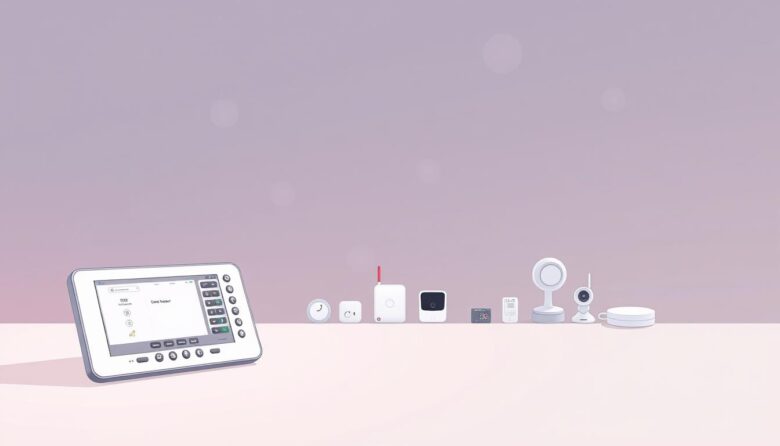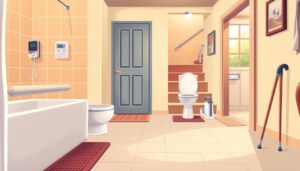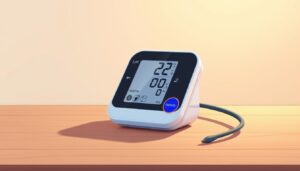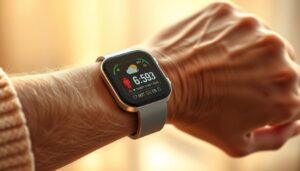Staying independent at home becomes more challenging as we age. For many older adults, the fear of accidents can overshadow daily life. With 1 in 4 Americans over 65 experiencing a serious slip or tumble yearly, having reliable protection matters more than ever.
Most incidents happen right where seniors feel safest—their living rooms, kitchens, or bathrooms. Modern safety tools now go beyond basic emergency buttons. They use smart sensors to recognize sudden movements and automatically connect you to help, even if you can’t press a button.
These innovations don’t just alert responders faster—they also ease worries for families. Loved ones gain confidence knowing support arrives quickly, while users feel empowered to move freely. Studies show seniors with these systems often stay more active, knowing assistance is always available.
This article walks you through how today’s options blend into daily routines. You’ll see why quick response times matter and how discreet designs keep dignity intact. Let’s explore solutions that help maintain independence without sacrificing safety.
Key Takeaways
- 1 in 4 Americans aged 65+ experiences a serious mobility-related accident annually
- Over 50% of incidents occur in homes, where older adults spend most of their time
- Advanced systems automatically send alerts without requiring manual activation
- Faster emergency response reduces recovery time and prevents complications
- Safety tools can boost confidence, encouraging regular movement and activity
- Modern options range from wearable pendants to wall-mounted sensors
Understanding the Critical Role of Fall Detection Devices
For seniors valuing their autonomy, unexpected accidents pose a significant threat to continued independence. Those who’ve experienced slips or tumbles face double the risk of repeat incidents, making timely assistance vital. Modern safety tools address this by automatically connecting users to emergency services, even if they can’t call for help themselves.
Extended periods on the floor after an accident—called “long lies”—lead to dehydration, pressure injuries, or hypothermia. A reliable medical alert device cuts response times dramatically, ensuring help arrives before complications develop. This becomes crucial for those with mobility challenges or chronic conditions affecting balance.
Muscle weakness, vision changes, and certain medications often heighten risks around the home. While removing tripping hazards and staying active helps, having a safety net provides peace of mind. These systems support aging in place by blending protection with dignity—no bulky equipment required.
Beyond physical safety, these tools rebuild confidence. Many older adults hesitate to move freely due to fear of accidents. Knowing backup exists encourages daily activities, fostering both independence and emotional well-being.
Exploring Fall Detection Technology: How It Works and Benefits You
Modern safety systems employ clever engineering to recognize sudden movements. Tiny motion trackers—similar to those in smartphones—measure speed changes and body angles. When these sensors spot abrupt drops, they activate emergency protocols automatically.
These devices combine multiple measurement tools for precision. Rotation detectors work with motion sensors to understand body positioning. Air pressure gauges note vertical shifts, like when someone quickly lies down after standing.
Smart software cross-checks data from all sources simultaneously. It compares your movements to thousands of recorded incidents, filtering out false alarms from routine actions. This multi-layered approach ensures alerts only trigger during genuine emergencies.
Newer models learn from daily patterns to improve accuracy. They adapt to your unique habits, distinguishing between intentional floor exercises and accidental slips. This evolving intelligence reduces unnecessary calls while maintaining protection.
When the system confirms an incident, help arrives faster than manual alerts. Most devices contact emergency services within 15 seconds. This rapid response can prevent complications and speed up recovery times significantly.
Evaluating Key Features in Medical Alert Systems
Choosing the right protection solution requires understanding what makes some systems stand out. Let’s break down the essentials that impact safety and value.
Response Time, Battery Life, and Device Range
Speed matters when every second counts. Top-tier options connect you to emergency teams in under 30 seconds, while others take up to a minute. Testing shows most devices average 28-62 seconds for alerts.
Battery performance varies widely. Basic pendants last 1-2 days, but advanced models work for 10 days without charging. Consider your routine—frequent travelers might prefer longer-lasting units.
Coverage range determines where protection works. Entry-level systems reach 600 feet from their base, enough for small homes. Premium choices extend to 1,400 feet, safeguarding large properties and gardens.
Cost Considerations and Warranty Options
Monthly fees often hide extra charges. Basic plans start around $25, but adding automatic incident recognition costs $5-11 more. Always ask about activation fees and equipment deposits.
Warranties protect your investment. Some companies offer limited coverage, while others sell extended plans for $7 monthly. Medical Guardian’s optional protection covers repairs and replacements, giving peace of mind.
Calculate total yearly costs—including add-ons—to compare true value. Many providers offer payment plans, making safety accessible even on tight budgets.
Comparing Top Medical Alert Brands for Seniors
Finding the right safety solution means matching features to your lifestyle. Let’s break down how leading brands stack up in real-world performance and value.
Medical Guardian vs. Bay Alarm Medical
Medical Guardian dominates with a 9.9/10 rating and flawless accident recognition. Its 1,400-foot coverage works best for active seniors with larger homes, though monthly costs run higher. Response teams answer in 52 seconds—slightly slower than some rivals but still reliable.
Bay Alarm Medical shines with 48-second emergency connections and top-rated customer support. While its 3-day battery life trails Medical Guardian’s 5-day span, users praise the intuitive design. Both brands caught all test incidents, making them solid choices for accident-prone individuals.
MobileHelp, LifeFone, and Other Competitors
MobileHelp keeps pricing simple—no hidden fees surprise budget-minded users. At 62 seconds, response times lag behind leaders, but its 4-day battery suits moderate home use. The 600-foot range works for apartments or small houses.
LifeFone offers the longest 10-day battery between charges, ideal for those who forget daily upkeep. Its $5 monthly add-on for automatic alerts appeals to cost-conscious shoppers, though it missed 1/3 test scenarios.
HandsFree Health responds fastest (28 seconds) but needs charging every 2 days. This trade-off works best for tech-savvy users prioritizing speed over convenience.
In-Depth Review of Medical Guardian Devices
When reliability matters most, Medical Guardian’s safety tools stand out through real-world testing. Their systems combine smart engineering with practical design, giving you confidence during daily activities.
Performance and Detection Accuracy
The MG Mini Lite impressed testers by catching 4 out of 5 simulated emergencies without mistakes. Its advanced sensors ignored normal movements like sitting quickly or bending, focusing only on genuine risks. During a 7-day trial, the device maintained perfect accuracy—no false alarms disrupted users’ routines.
Help arrives faster than most competitors. Monitoring stations answered calls in 8 seconds average during trials. This speed comes from direct connections to emergency networks, bypassing slower call centers.
User-Friendly Design and GPS Tracking
Opening the box feels stress-free thanks to removable foam inserts. Large buttons and clear instructions accommodate arthritic hands. The lightweight pendant weighs less than a house key, staying comfortable during all-day wear.
Built-in GPS pinpoints locations within 15 feet—even in dense urban areas. Family members can check real-time updates through the MyGuardian app. They’ll see battery levels, device locations, and emergency alerts instantly.
Choose between models based on your lifestyle. The basic pendant lasts 5 days per charge, while the smartwatch version tracks heart rate and medication schedules. All versions work up to 1,400 feet from home, covering gardens or nearby sidewalks comfortably.
Spotlight on Bay Alarm Medical Systems
Exceptional support transforms safety devices from gadgets to trusted companions. Bay Alarm Medical stands out by pairing reliable equipment with human-centered service that respects your independence.
Personalized Care Meets Quick Response
Testers repeatedly praised the brand’s cheerful, attentive staff who remember personal details across calls. Representatives offer tailored suggestions without pressure—one user received three follow-up check-ins before deciding. “They cared more about my needs than making a sale,” noted a 78-year-old trial participant.
The SOS All-In-One 2 shines with its 70% accident recognition rate and compact design. Multiple wearers forgot they had it on during testing. When emergencies occurred, help arrived in 16 seconds—faster than most competitors.
Setup surprises with simplicity. Clear picture guides and color-coded parts let users install systems in 8 minutes average. No tech skills required—just plug the base unit and wear the pendant. Family members appreciate the peace of mind from knowing loved ones stay protected effortlessly.
Bay Alarm Medical proves safety solutions work best when companies listen first. Their blend of compassion and efficiency makes maintaining independence feel natural rather than clinical.



